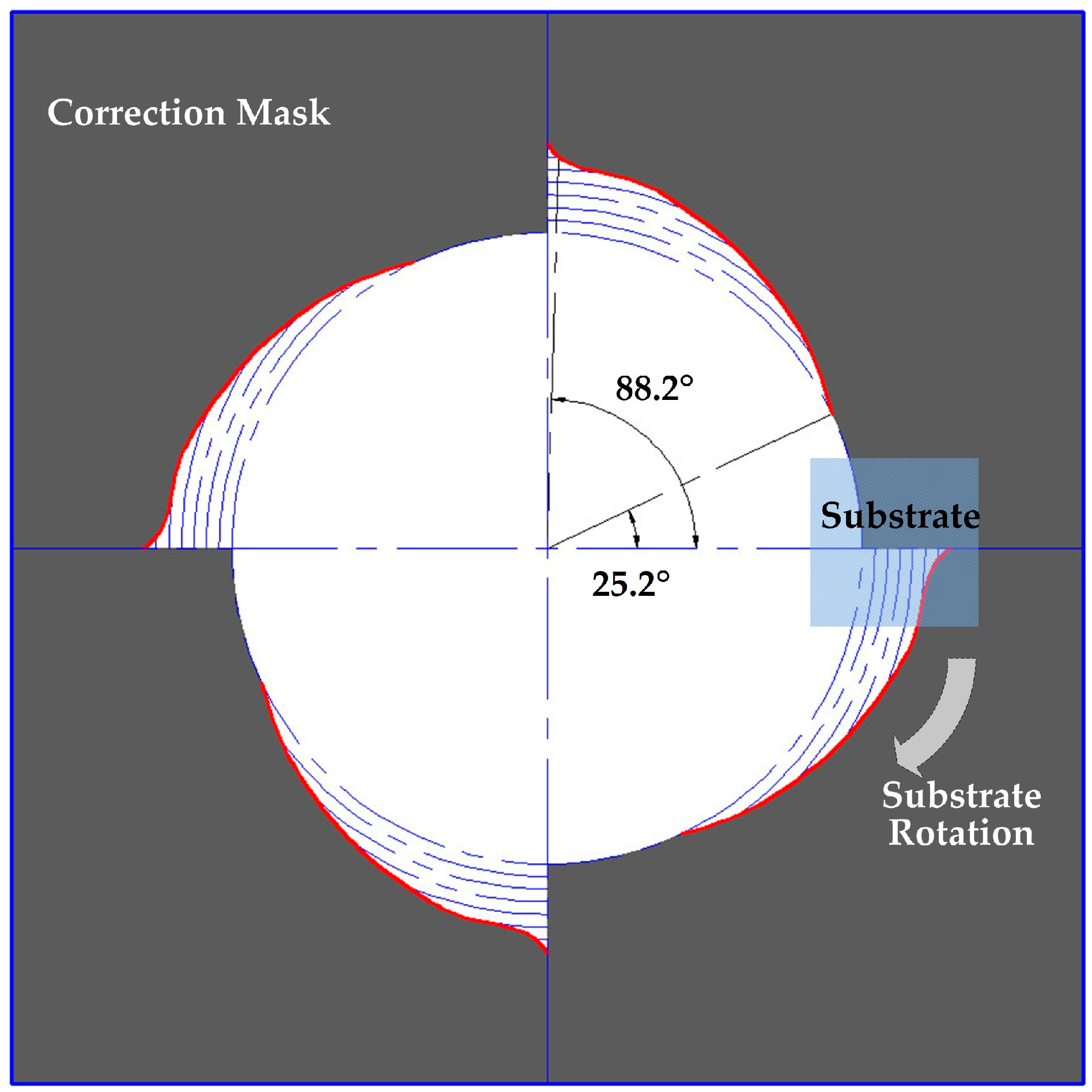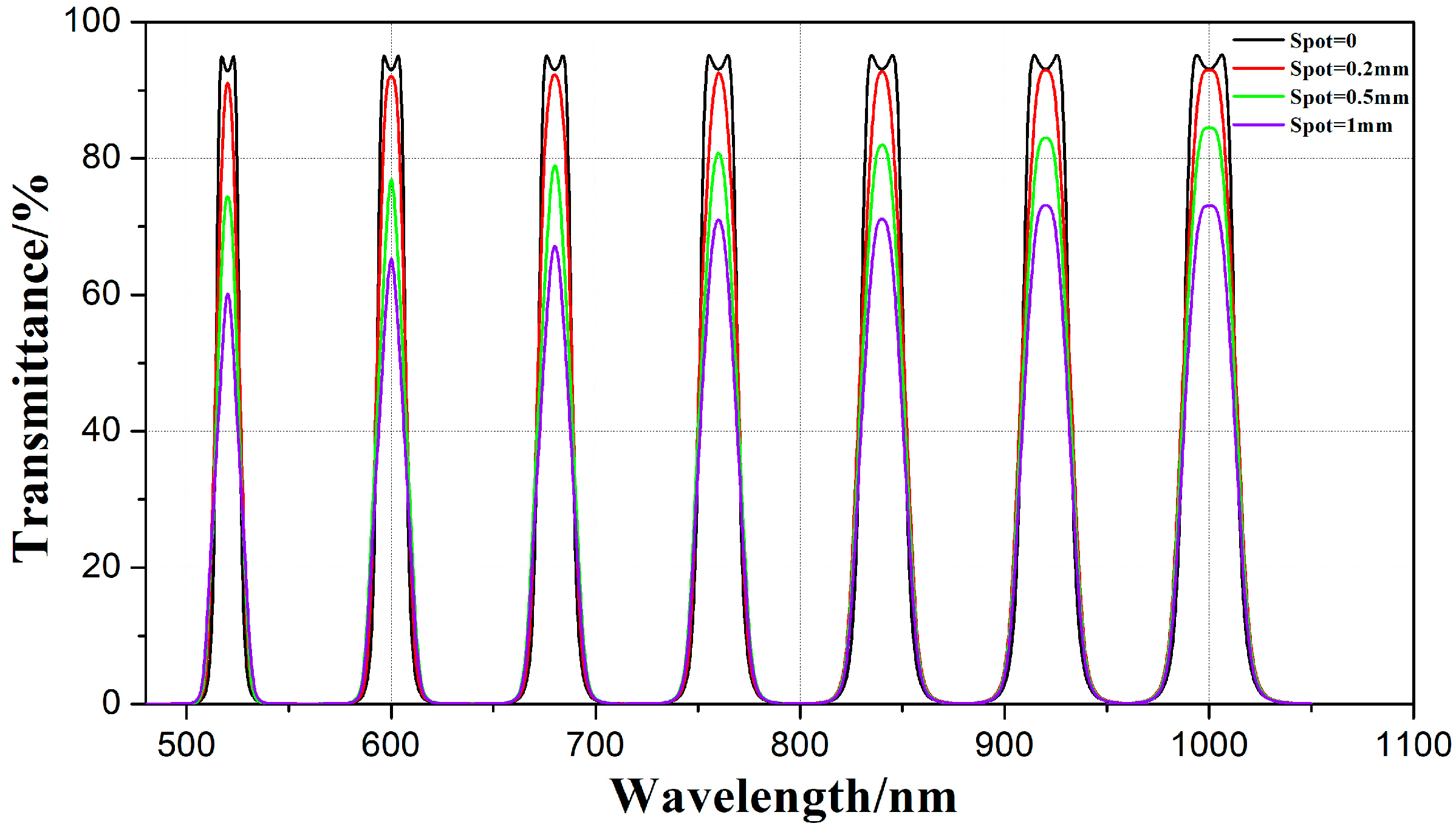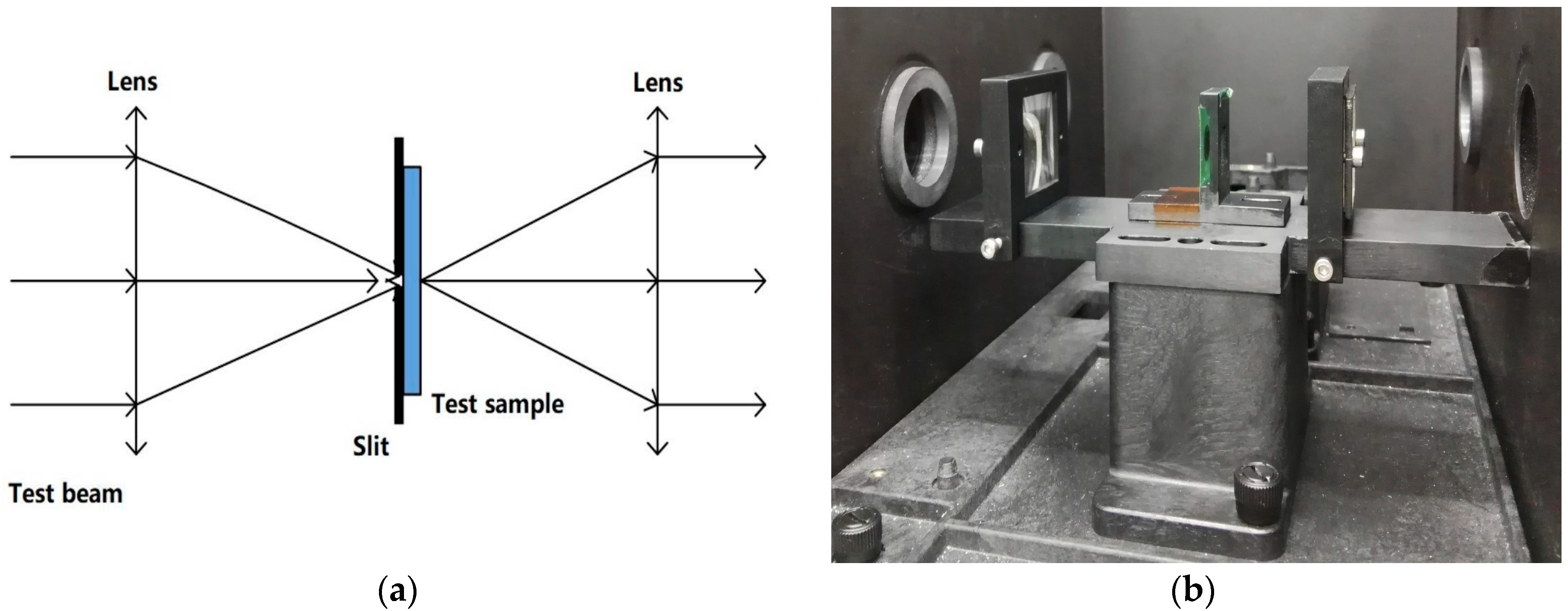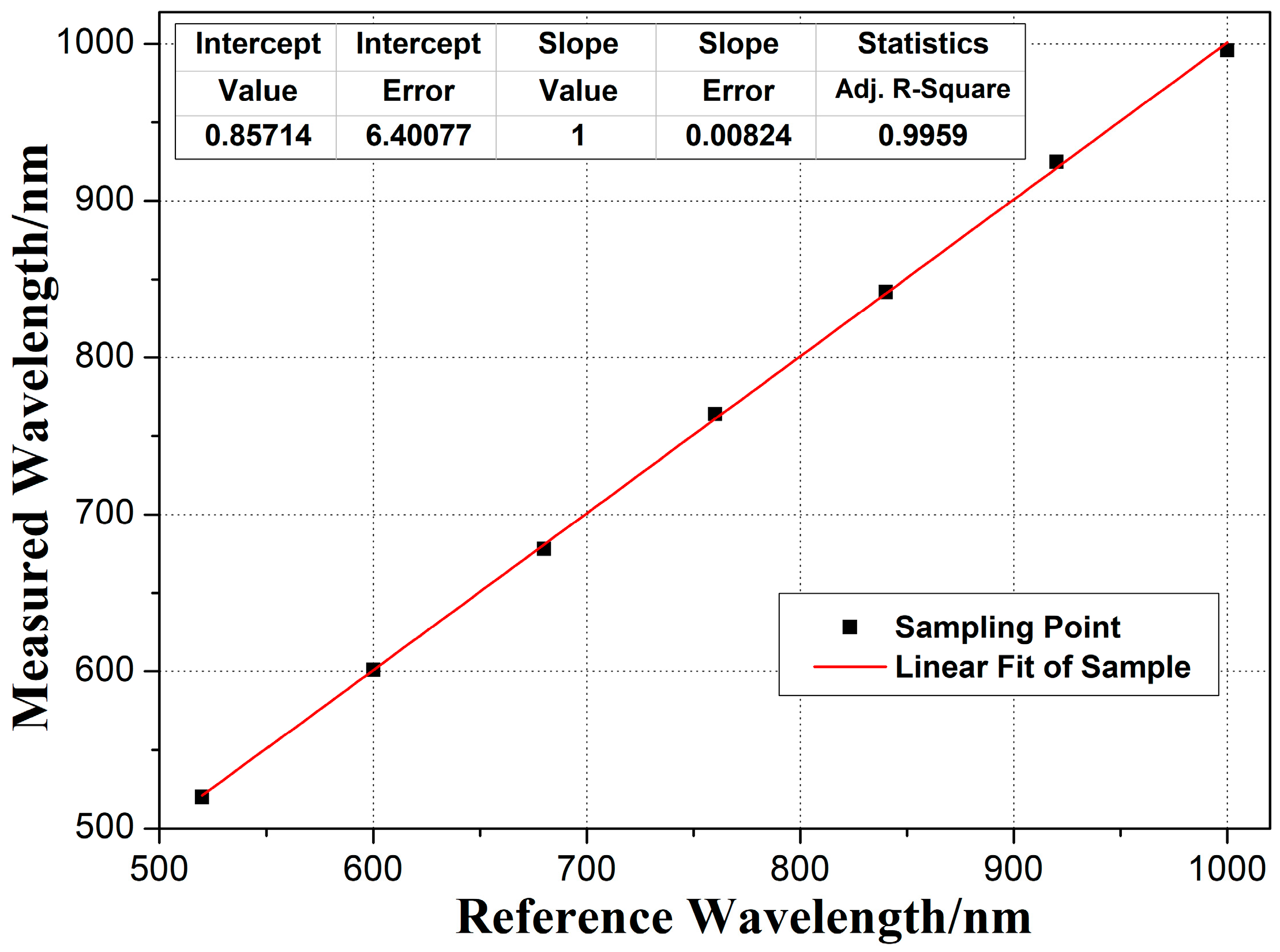Preparation and Spectrum Characterization of a High Quality Linear Variable Filter
Abstract
:1. Introduction
2. Experimental Details
2.1. Coating Design for LVF
2.2. Preparation and Film Thickness Matching of LVF
3. Results and Discussion
4. Conclusions
Author Contributions
Funding
Acknowledgments
Conflicts of Interest
References
- Emadi, A.; Wu, H.; de Graaf, G.; Wolffenbuttel, R. Design and implementation of a sub-nm resolution microspectrometer based on a linear-variable optical filter. Opt. Express 2012, 20, 489–507. [Google Scholar] [CrossRef] [PubMed]
- McLeod, R.R.; Honda, T. Improving the spectral resolution of wedged etalons and linear variable filters with incidence angle. Opt. Lett. 2005, 30, 2647–2649. [Google Scholar] [CrossRef] [PubMed]
- Sheng, B.; Chen, P.; Tao, C.; Hong, R.; Huang, Y.; Zhang, D. Linear variable filters fabricated by ion beam etching with triangle-shaped mask and normal film coating technique. Chin. Opt. Lett. 2015, 13, 122301. [Google Scholar] [CrossRef]
- Williams, C.; Rughoobur, G.; Flewitt, A.J.; Wilkinson, T.D. Single-step fabrication of thin-film linear variable bandpass filters based on metal–insulator–metal geometry. Appl. Opt. 2016, 55, 9237–9241. [Google Scholar] [CrossRef] [PubMed]
- Ji, P.; Gao, S.; Park, C.-S.; Lee, S.-S.; Choi, D.-Y. Linear variable filter enabling an enhanced wavelength gradient based on shadow-mask sputtering. Microw. Opt. Technol. Lett. 2017, 59, 3142–3146. [Google Scholar] [CrossRef]
- Piegari, A.; Bulir, J.; Sytchkova, A.K. Variable narrow-band transmission filters for spectrometry from space. 2. fabrication process. Appl. Opt. 2008, 47, C151–C156. [Google Scholar] [CrossRef] [PubMed]
- Mokhtari, A.; Jamshidi, K.; Preußler, S.; Zadok, A.; Schneider, T. Tunable microwave-photonic filter using frequency-to-time mapping-based delay lines. Opt. Express 2013, 21, 21702–21707. [Google Scholar] [CrossRef] [PubMed]
- Diest, K.; Dionne, J.A.; Spain, M.; Atwater, H.A. Tunable color filters based on metal−insulator−metal resonators. Nano Lett. 2009, 9, 2579–2583. [Google Scholar] [CrossRef] [PubMed]
- Wiesent, B.R.; Dorigo, D.G.; Koch, A.W. Limits of IR-spectrometers based on linear variable filters and detector arrays. In Instrumentation, Metrology, and Standards for Nanomanufacturing IV, Proceedings of Instrumentation, Metrology, and Standards for Nanomanufacturing IV, San Diego, CA, USA, 2–4 August 2010; Postek, M.T., Ed.; SPIE: Bellingham, WA, USA, 2010; Volume 7767. [Google Scholar] [CrossRef]
- Murr, P.J.; Schardt, M.; Koch, A.W. Static hyperspectral fluorescence imaging of viscous materials based on a linear variable filter spectrometer. Sensors 2013, 13, 12687–12697. [Google Scholar] [CrossRef] [PubMed]
- Law, C.S.; Santos, A. Realisation and optical engineering of linear variable bandpass filters in nanoporous anodic alumina photonic crystals. Nanoscale 2017, 9, 7541–7550. [Google Scholar] [CrossRef]
- Hendrix, K. Linear variable filters for NASA’s OVIRS instrument: Pushing the envelope of blocking. Appl. Opt. 2017, 56, C201–C205. [Google Scholar] [CrossRef] [PubMed]
- Ghaderi, M.; Ayerden, N.P.; Emadi, A.; Enoksson, P.; Correia, J.H.; de Graaf, G.; Wolffenbuttel, R.F. Design, fabrication and characterization of infrared LVOFs for measuring gas composition. J. Micromech. Microeng. 2014, 24, 084001. [Google Scholar] [CrossRef]
- Willey, R.R. Achieving narrow bandpass filters which meet the requirements for DWDM. Thin Solid Films 2001, 398–399, 1–9. [Google Scholar] [CrossRef]
- Tien, C.L. Influence of ejection angle on residual stress and optical properties of sputtering Ta2O5 thin films. Appl. Surf. Sci. 2008, 255, 2890–2895. [Google Scholar] [CrossRef]
- Tabata, A.; Matsuno, N.; Suzuoki, Y.; Mizutani, T. Optical properties and structure of SiO2 films prepared by ion-beam sputtering. Thin Solid Films 1996, 289, 84–89. [Google Scholar] [CrossRef]
- Shang, P.; Xiong, S.; Li, L.; Tian, D.; Ai, W. Investigation on thermal stability of Ta2O5, TiO2 and Al2O3 coatings for application at high temperature. Appl. Surf. Sci. 2013, 285, 713–720. [Google Scholar] [CrossRef]
- Nguyen, J.; Yu, J.S.; Evans, A.; Slivken, S.; Razeghi, M. Optical coatings by ion-beam sputtering deposition for long-wave infrared quantum cascade lasers. Appl. Phys. Lett. 2006, 89, 111113. [Google Scholar] [CrossRef]
- Malobabic, S.; Jupé, M.; Ristau, D. Spatial separation effects in a guiding procedure in a modified ion-beam-sputtering process. Light Sci. Appl. 2016, 5, e16044. [Google Scholar] [CrossRef]
- Çetinörgü, E.; Baloukas, B.; Zabeida, O.; Klemberg-Sapieha, J.; Martinu, L. Optical and tribomechanical stability of optically variable interference security devices prepared by dual ion beam sputtering. Appl. Opt. 2011, 50, 3351–3359. [Google Scholar] [CrossRef] [PubMed]
- Ko, C.-H.; Chang, K.-Y.; Huang, Y.-M. Analytical modeling and tolerance analysis of a linear variable filter for spectral order sorting. Opt. Express 2015, 23, 5102–5116. [Google Scholar] [CrossRef] [PubMed]
- Abel-Tibérini, L.; Lemarquis, F.; Lequime, M. Masking mechanisms applied to thin-film coatings for the manufacturing of linear variable filters for two-dimensional array detectors. Appl. Opt. 2008, 47, 5706–5714. [Google Scholar] [CrossRef] [PubMed]
- Hsu, J.-C. Analysis of the thickness uniformity improved by using wire masks for coating optical bandpass filters. Appl. Opt. 2014, 53, 1474–1480. [Google Scholar] [CrossRef] [PubMed]
- Murr, P.J.; Wiesent, B.R.; Hirth, F.; Koch, A.W. Thin film measurement system for moving objects based on a laterally distributed linear variable filter spectrometer. Rev. Sci. Instrum. 2012, 83, 035110. [Google Scholar] [CrossRef] [PubMed]











| Position on Sample/mm | d0 (nm) | d1 (nm) | dt (nm) | θ1 (°) | θt (°) |
|---|---|---|---|---|---|
| 0 | 1175 | 507 | 520 | 90 | 88.2485 |
| 2 | 1179 | 508 | 600 | 90 | 77.66021 |
| 4 | 1184 | 511 | 680 | 90 | 67.3997 |
| 6 | 1185 | 514 | 760 | 90 | 57.00447 |
| 8 | 1190 | 518 | 840 | 90 | 46.875 |
| 10 | 1182 | 519 | 920 | 90 | 35.56561 |
| 12 | 1186 | 522 | 1000 | 90 | 25.21084 |
| Position on Sample (mm) | Deposition Rate of Ta2O5 (nm/s) | Deposition Rate of SiO2 (nm/s) |
|---|---|---|
| 0 | 0.1079 | 0.1017 |
| 2 | 0.1262 | 0.1186 |
| 4 | 0.1466 | 0.1372 |
| 6 | 0.1635 | 0.1524 |
| 8 | 0.1799 | 0.1671 |
| 10 | 0.1961 | 0.1824 |
| 12 | 0.2134 | 0.1975 |
© 2018 by the authors. Licensee MDPI, Basel, Switzerland. This article is an open access article distributed under the terms and conditions of the Creative Commons Attribution (CC BY) license (http://creativecommons.org/licenses/by/4.0/).
Share and Cite
Tang, H.; Gao, J.; Zhang, J.; Wang, X.; Fu, X. Preparation and Spectrum Characterization of a High Quality Linear Variable Filter. Coatings 2018, 8, 308. https://doi.org/10.3390/coatings8090308
Tang H, Gao J, Zhang J, Wang X, Fu X. Preparation and Spectrum Characterization of a High Quality Linear Variable Filter. Coatings. 2018; 8(9):308. https://doi.org/10.3390/coatings8090308
Chicago/Turabian StyleTang, Haolong, Jinsong Gao, Jian Zhang, Xiaoyi Wang, and Xiuhua Fu. 2018. "Preparation and Spectrum Characterization of a High Quality Linear Variable Filter" Coatings 8, no. 9: 308. https://doi.org/10.3390/coatings8090308




